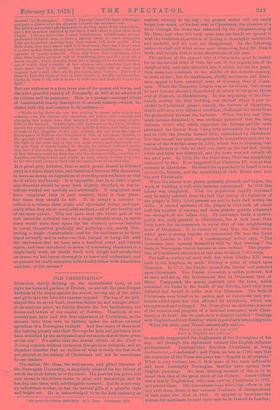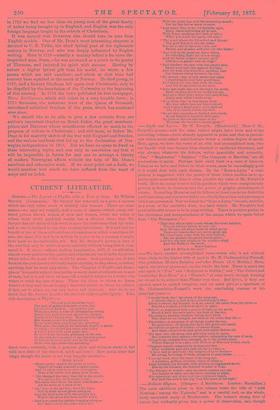OLD CHRISTIANIA.*
DRIFTING, slowly drifting up the interminable fjord, on our right the terraced gardens of Drobak, on our left the pine-fringed darkness of the slopes against the sunset, we slip out of the strait and glide into the lake-like expanse beyond. The top of the gulf, shaped like an arrow-head, broadens before us, and straight ahead, at its northern point, we faintly discern the low battlements, the domes and towers of the capital of Norway. Hundreds of our countrymen have had this first experience of Christiania, as the steamer bore them into its harbour under the saffron-coloured splendour of a Norwegian twilight. And how many of them next day looking piously into their Murrays for help and guidance, have been stultified by the antiquated and erroneous sketch there given of the city We notice that the newest edition of the Guide to Norway reprints without correction this precious chronicle, and we therefore consider that an outline of what is really the best book yet printed on the history of Christiania will not be unwelcome to our readers.
The author, Mr. Daae, the well-known and gifted librarian of the Norwegian University, is singularly adapted for the labour of which the book before us is the result. His position has given him easy access to the richest stores in print and manuscript, and he has dug into them with indefatigable research. But he is not only an industrious worker, he has the natural gifts of a graceful style and bright wit. He is acknowledged to be the best authority on
• Det parole Christiania (1624-1814). AI L. Daae. Christiania, 1871. matters relating to the city ; the present writer will not easily forget how much, on his first visit to Christiania, the pleasure of a drive through the town was enhanced by the companionship of Mr. Daae, and when this book came into our hands we opened it with the confident expectation of finding it thoroughly instructive and readable, and we were not disappointed. In the following notice we shall cull what seems most interesting from Mr. Daae's work, and mingle with it some observations of our own.
The nucleus of the present city of Christiania must be looked for in the ancient town of Oslo, far east of the original site of its daughter city, and only absorbed into it within the last few years. Oslo came into existence in the middle of the eleventh century, or even earlier ; but its inhabitants, chiefly merchants and fisher- men, appear to have consisted more of Germans than of Norse- men. When the Hanseatic League was at its climax, Oslo seems to have become almost a dependency or colony of the great Hanse city of Rostock, in Mecklenburg. In the beginning of the four- teenth century the first building was erected which is now in- cluded in Christiania proper, namely, the fortress of Akershuus, which still, in a very different condition, challenges the world from the promontory between the harbours. When Sweden and Den- mark became disunited, it was suddenly perceived that the long distance (3,000 ells) which separated the fortress and the town prevented the former from being very serviceable to the latter ; and in 1523 the Swedes burned Oslo, unhindered by Akershuus. But this inroad was quite unimportant in comparison with the in- vasion of the Swedish army in 1567, which was so alarming that the inhabitants of Oslo set their own town on fire and fled. Every house and farm was destroyed, and the town was not rebuilt till the next year. In 1624, for the third time, Oslo was completely destroyed by fire. It so happened that Christian IV. was at that moment in Akershuus. He seized the opportunity to found a town around the fortress, and the inhabitants of Oslo flitted over into the new Christiania.
1Vhen the streets were pretty generally planned and begun, the work of building a wall with bastions commenced. In 1633 this labour was completed. That the population rapidly increased may be safely inferred from the fact that during the visitation of the plague in 1630, 3,000 persons are said to have died within the walls. A second epidemic of the plague in 1654 took off about half this number of victims, and these attacks greatly exhausted the strength of the infant city. To encourage trade, a munici- pality was early granted to Christiania, but it took more than forty years for its commerce to equal that of the neighbouring town of Drammen. It is curious to read that the first event which gave a strong impulse to commercial life was the Great Fire of London in 1666. A contemporary writer says, " The Norsemen have warmed themselves well by that burning ;" the trade in Norwegian timber became at once trebled. The popula- tion of Christiania amounted at this time to about 7,000 souls.
For half•a-century all went well, but when Charles XII. came back to his kingdom he made Nor way a point of attack upon Denmark. In 1716, the Swedes crossed the border and marched upon Christiania. The Danish Governor, a selfish poltroon, fled at once, and set up the Government first at Drammen, then at Skien. Unopposed, the enemy marched into the town, which remained six weeks in the hands of the Swedes, until they were defeated and forced to retire over the Glommen. The walls of Christiania were found to be useless, and in future the only pro- tection relied upon was that afforded by Akershuus, which was strengthened and enlarged. Mr. Daae gives an elaborate account of the creation and progress of a national commerce, with Chris- tiania at its head ; but we pass on to a chapter entitled " Dealings with England and their Results," which is peculiarly interesting to us.
When the witty poet Wessel sarcastically said,-
" There are no people in the world
Save in England and with us,"
he scarcely exaggerated the Anglomania of the Norwegians of his day. All through the eighteenth century this English influence predominated. Pontoppiddan describes Christiania as being londonniseret,—Londonised ; and Pram, as late as 1790, says that the character of the Norse sea-ports was " English in all respects."
What is very curious, too, is that some of the most influential and most thoroughly Norwegian families have sprung from English parentage. No more striking instance of this is to be found than that of the great stock of the Colletts. James Collett was a sturdy Englishman, who came over to Christiania in 1683, and settled there. His descendants have filled high offices in the city ever since, down to the eminent Professor of Jurisprudence of that name who died in 1851. It appears to have been the custom for merchants to send their sons to be trained in London ;
in 1759 we find no less than six young men of the great family of Anker being brought up in England, and English was the only foreign language taught in the schools of Christiania.
It was natural that literature also should take its tone from English models. One of Mr. Daae's most interesting chapters is devoted to C. B. Tullin, the chief lyrical poet of the eighteenth century in Norway, and who was deeply influenced by English writing. Born in 1728—exactly a century before a far more dis- tinguished man, Ibsen,—he was saturated as a youth in the poetry of Thomson, and imitated its spirit with success. Having by nature a higher lyrical gift than his model, he wrote a few poems which are still excellent, and which at that time had scarcely been equalled in the south of Norway. He died young, in 1765, and a literary blindness fell again over Christiania, only to be dispelled by the foundation of the University at the beginning of this century. In 1763 the town published its first newspaper, Norse Intelligences, whiCh still exists in a very humble form ; in 1770 Struensee, the notorious lover of the Queen of Denmark, introduced unlimited freedom of the press, which has continued ever since.
We should like to be able to give a few extracts from our author's important chapter on Bernt Anker, the great merchant- prince and Mmcenas whose munificence effected so mach in the progress of culture in Christiania ; and still more, to follow Mr. Daae in his masterly sketch of the war with England and Sweden, and the various incidents that led up to the declaration of Nor- wegian independence in 1814. But we have no space to dwell on these interesting topics, and can only in conclusion say that it will be impossible in future for any one to attempt a history of modern Norwegian affairs without the help of Mr. Daae's excellent and exhaustive work. If we must point out a fault, we would mention how much we have suffered from the want of maps and an index.



































 Previous page
Previous page